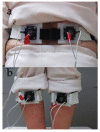Postural Sway in Older Patients with Sagittal Imbalance and Young Adults during Local Vibratory Proprioceptive Stimulation
- PMID: 33672014
- PMCID: PMC7919372
- DOI: 10.3390/healthcare9020210
Postural Sway in Older Patients with Sagittal Imbalance and Young Adults during Local Vibratory Proprioceptive Stimulation
Abstract
This study aimed to assess differences in somatosensory control strategies between older patients with sagittal imbalance and young adults during postural tasks. The center of pressure displacement in 27 older patients with sagittal imbalance and 27 young adults was determined upon standing blindfolded on a balance board. Vibratory stimulation at 56 to 100 Hz was applied bilaterally to the gastrocnemius and soleus muscles (GS) and lumbar multifidus to evaluate the contributions of proprioceptive signals to postural control. Data of older patients and young adults were compared using the Mann-Whitney U-test or independent sample t-tests. Compared with the young adults, the older patients were significantly more reliant on the GS (p < 0.005) for their postural control and showed a higher relative proprioceptive weighting ratio (RPW) (p = 0.038). The postural strategy adopted by the older patients depended on the level of proprioceptive stimulation applied to the GS, and the postural control strategy of the ankle correlated with RPW. Overall, this study identifies RPW as a novel measure of postural strategy in older patients with sagittal imbalance and provides an understanding of strategies used to maintain balance, which may assist in developing preventative measures to reduce the risk of falls.
Keywords: muscle spindle; postural control; proprioceptive; sagittal imbalance.
Conflict of interest statement
The authors declare no conflict of interest.
Figures


Similar articles
-
Proprioceptive Weighting Ratio for Balance Control in Static Standing Is Reduced in Elderly Patients With Non-Specific Low Back Pain.Spine (Phila Pa 1976). 2018 Dec 15;43(24):1704-1709. doi: 10.1097/BRS.0000000000002817. Spine (Phila Pa 1976). 2018. PMID: 30059489
-
Proprioceptive reliance on trunk muscles for maintaining postural stability decreases in older patients with sagittal imbalance.Gait Posture. 2023 Sep;105:1-5. doi: 10.1016/j.gaitpost.2023.06.022. Epub 2023 Jul 4. Gait Posture. 2023. PMID: 37451033
-
Proprioceptive change impairs balance control in older patients with low back pain.J Phys Ther Sci. 2017 Oct;29(10):1788-1792. doi: 10.1589/jpts.29.1788. Epub 2017 Oct 21. J Phys Ther Sci. 2017. PMID: 29184289 Free PMC article.
-
Postural Strategy in Elderly, Middle-Aged, and Young People during Local Vibratory Stimulation for Proprioceptive Inputs.Geriatrics (Basel). 2018 Dec 19;3(4):93. doi: 10.3390/geriatrics3040093. Geriatrics (Basel). 2018. PMID: 31011128 Free PMC article.
-
Postural Sway during Local Vibratory Stimulation for Proprioception in Elderly Individuals with Pre-Sarcopenia.Phys Ther Res. 2020 Jul 22;23(2):149-152. doi: 10.1298/ptr.E10001. eCollection 2020. Phys Ther Res. 2020. PMID: 33489652 Free PMC article.
Cited by
-
Impact of Visual Input and Kinesiophobia on Postural Control and Quality of Life in Older Adults During One-Leg Standing Tasks.Vision (Basel). 2025 Mar 20;9(1):24. doi: 10.3390/vision9010024. Vision (Basel). 2025. PMID: 40137936 Free PMC article.
-
Improved postural control in a patient having adult spinal deformity and previous thoraco-lumbar scoliosis surgery: a Chiropractic Biophysics® case report.AME Case Rep. 2024 Apr 22;8:58. doi: 10.21037/acr-23-183. eCollection 2024. AME Case Rep. 2024. PMID: 39091542 Free PMC article.
-
Biological Responses to Local Vibratory Stimulation for the Lower Legs and Lower Back and Criterion Values Based on Sweep Frequencies of Healthy Individuals: An Observational Study.Healthcare (Basel). 2023 Aug 9;11(16):2243. doi: 10.3390/healthcare11162243. Healthcare (Basel). 2023. PMID: 37628441 Free PMC article.
-
Non-surgical reduction in thoracolumbar kyphosis and sagittal vertical axis corresponding with improved sensorimotor control in an older adult with spinal deformity: a Chiropractic Biophysics® case report.J Phys Ther Sci. 2024 Nov;36(11):756-764. doi: 10.1589/jpts.36.756. Epub 2024 Nov 1. J Phys Ther Sci. 2024. PMID: 39493686 Free PMC article.
References
-
- Schwab F., Dubey A., Gamez L., El Fegoun A.B., Hwang K., Pagala M., Farcy J.-P. Adult Scoliosis: Prevalence, SF-36, and Nutritional Parameters in an Elderly Volunteer Population. Spine. 2005;30:1082–1085. doi: 10.1097/01.brs.0000160842.43482.cd. - DOI - PubMed
Grants and funding
LinkOut - more resources
Full Text Sources
Other Literature Sources

